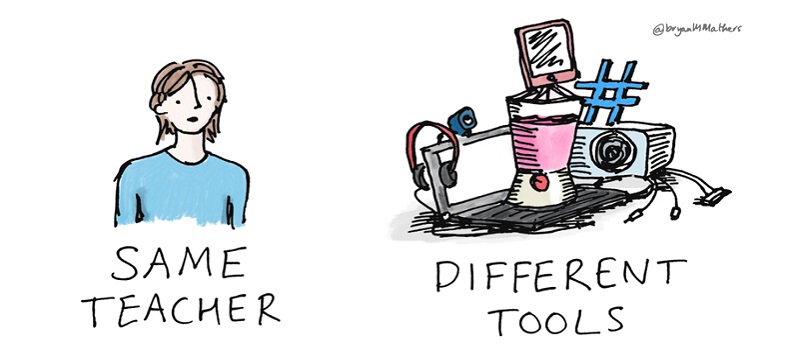1 Synchronous and asynchronous modes of teaching
One of the most common ways to think about teaching online is to consider whether it might be synchronous, asynchronous, or a mixture of both.
Synchronous teaching
The teacher’s role in online synchronous teaching might not be so very different from their role in the face-to-face environment. Synchronous learning may feature webinars (live online lessons), group chats, or drop-in sessions where teachers are available to help at a particular time. However, teaching synchronously online will require some new skills to be developed, for example in managing the faster pace of teaching.
If a course is delivered entirely through synchronous teaching, face-to-face or online, this can limit flexibility for learners. Because of the need for everyone to be present at the same time (even if online), all students must work through the course at a similar pace, allowing only minimal flexibility in scheduling. As everyone needs to be online together, if a learner is not available for a lesson, they miss it (although some teachers or learning organisations will record lessons for these students to view later).
Synchronous teaching is where the teacher is present at the same time as the learner(s). This is almost always the case in a face-to-face environment. Synchronous teaching can also take place via online learning, through the use of video conferencing and live chat or instant messaging. As with the face-to-face environment, the learners in synchronous online teaching can ask questions in real time.
Asynchronous online teaching
Asynchronous online teaching is where teaching materials are posted online, and learners work through them in their own time, communicating with each other and the teacher via discussion boards or forums, or by email. Good asynchronous teaching will include a variety of media, including (but not limited to) audio and video clips. With an asynchronous mode of teaching, the learner can work at their own pace and at times of day which are convenient for them. The teacher may find that the pattern of their input is very different from the synchronous environment, with many shorter visits to the discussion boards or forums being more valuable to the learners than one single, longer session. There may still be deadlines for work to be submitted for feedback, and there may be a recommended schedule for students to follow so that they have some idea of what they should be doing and when. As you will discover later in this week, a ‘blended’ approach can help teachers to bring together the advantages of synchronous and asynchronous teaching, and of online and face-to-face teaching, into a single experience.
The importance of collaboration
Collaboration between students, and between students and teachers, is an important factor in both synchronous and asynchronous online teaching, helping to create a sense of connection between all participants and to build a sense of community and shared purpose.
Collaboration in a synchronous environment can be achieved in much the same way as in a face-to face-classroom, with discussions and group tasks. In the asynchronous environment, collaboration can be trickier but is still very important in reducing the sense of isolation learners may feel when working online. Discussions and group tasks can work just as well asynchronously as synchronously. Indeed, because of the lack of time constraints, learners can spend time composing a quality response when contributing to an asynchronous online discussion.
Introduction

